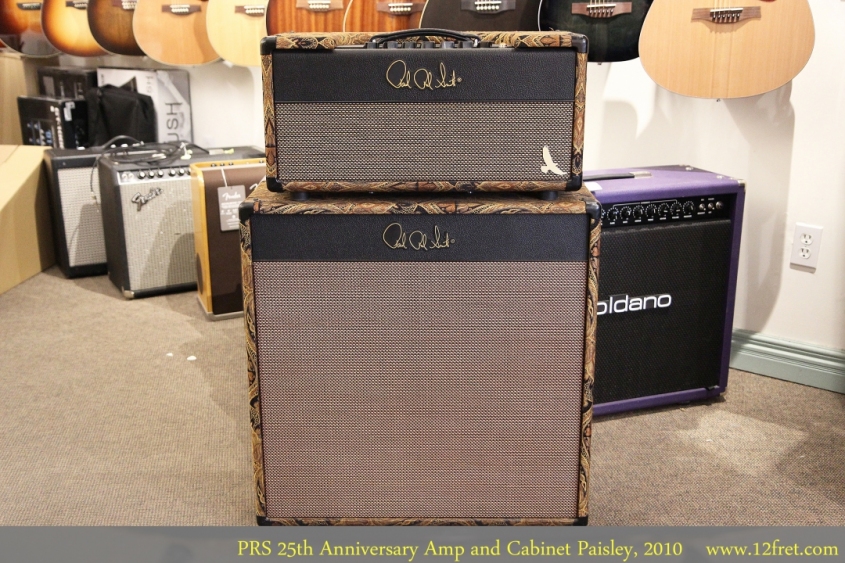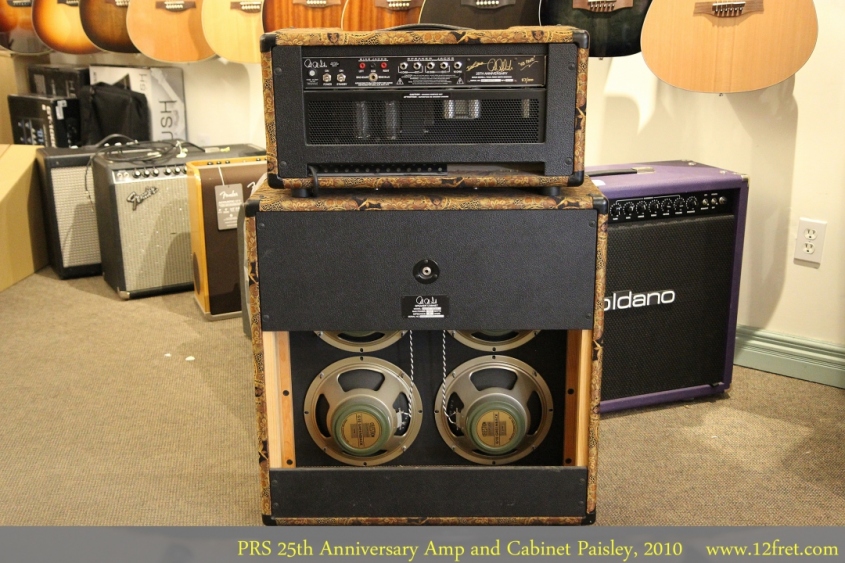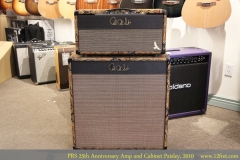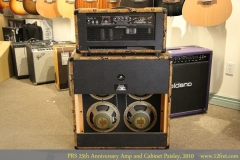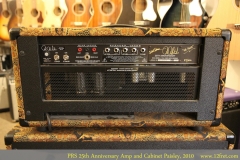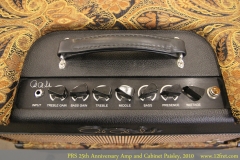Here we have an “HB Proto” version of The PRS 25th Anniversary Amplifier, a scalable 50 watt tube amp with 4×10 cabinet and dressed in matching paisley! This is a rare amp, built during 2010 and designed by Paul Reed Smith and Doug Sewell. Doug Sewell was by career an architect but his passion is to build amplifiers.
The PRS 25th Anniversary Amplifier delivers a smooth, creamy tone and is based on the late 1960s ‘Plexi’ design. This example is apparently from the late prototype stage and is signed and numbered as 57 of 100 amps built. It uses a pair of EL34 tubes and delivers sound through four Celestion G10 Greenback speakers.
Available in two power versions, 50 and 100 watts, this is the 50 watt version and is in excellent condition with no real wear or damage to the paisley covering. Please note – the weight listed below is for the 50 watt amp head ONLY (34 lbs, 15.45kg). The 4×10 cabinet weighs an additional 37.5 lbs or 17.05kg.
From the PRS 25th anniversary amplifier manual, here is a listing of the control functions:
Treble Gain: The circuitry is configured like a vintage two-channel amplifier that has been ‘bridged’ with a Y-cord. The treble gain acts like the volume of the brighter channel. It can be used like an additional tone knob to adjust the overall tone in a brighter or darker fashion, relative to the bass channel gain control.
Bass Gain: As noted above, this volume controls the internal bass channel that is linked to the treble channel. Increase this channel’s volume relative to the treble gain control to adjust the overall tone of the amp in a brighter or darker fashion.
Treble: The treble control is very sensitive in both clean and dirty settings. Like all of the control knobs, there are no numbers to encourage you to set the amp with your ears. Middle: Using less mids creates crisper, more “hollow” sounding tones. Clean settings using less mids can sound very American, working well with single coil tones for clean blues and country. Adding mids transforms the tone to a warm, fatter jazz-approved tone. Distortion with more mids can sound very 60s and 70s, less mids ventures into 80s metal tones.
Bass: The low end control allows you to tailor the amount of bass appropriate for the speakers and cabinet you are playing through. Inherently bassy cabinets can sound very boomy with high bass settings on the amp. Open back cabinets generally can accept higher bass settings without this.Presence: An additional control to adjust the overall brightness and high-end gain of the amp.
Wattage: This six position switch acts as a voltage divider in the phase inverter to incrementally reduce the drive signal going to the power tubes. The last position disconnects the switch from the circuitry, leaving the stock values unaltered. When running the amp wide-open, it is suggested to select the second position (one degree of attenuation) for extended tube life. Do not adjust the wattage control while playing guitar though the amp at high volumes because of potential volume spikes between switch positions.
Paul Reed Smith himself describing meeting Doug Sewell and the development of the PRS Amplifier line:
“Back in 2006, I was at the Dallas Vintage Guitar Show and my band was scheduled to perform a few times. A friend said, “Hey. You need an amp to play through, and I have a friend who makes great amps.” He took me to the booth of a Texas amp builder, Doug Sewell.
I loved the way his amps sounded, and after barely saying hello, Doug and I were inside rewiring the amp I was going to play through. Since that day, Doug and I have spent years rewiring and listening to every single possible variation to finalize the circuits. Our goal was to have highly usable and musical amplifiers.
I am not an amp collector. I am an amplifier user who keeps the amps I am presently playing through. That said, after Doug and I got several of the prototypes finalized, I sold some of my old coveted live and studio amps because ours sounded considerably better.
The next step was to take the prototypes to musicians who are known for their amplifier tone as well as their playing. What’s interesting is that when I spoke to these artists about trying the amps, they all said the same thing. “Sure I’ll use them, if I love them.”In a real way, amplifiers are musical instruments. They are the devices that “amplify” the sound of the player’s hands, the guitar and possibly the pedal board. They must share many qualities. They must work – they have to have a beautiful balance of bass, midrange, and treble; the highs should be sweet – not harsh; they should be easy to operate and be highly musical. In addition, amps should clean up really well when you turn your guitar down.
The final quality that Doug and I looked for are amps that sound good no matter where the knobs are. It is a rare quality that we insisted on. I hope this hand-crafted amplifier gives you years of enjoyment, musical results, and pride in ownership. I appreciate your confidence.”
- Model: 25th Anniiversary HB Proto
- Year: Current |
- Class: Used
- Serial Number: 100272 53/100 built 2010
- Country of Origin: USA
- Condition: Very Good
- Date Posted: 21/10/2020
- This item has sold
- Consignment Item
- Weight: 34lbs 15.5kgs
